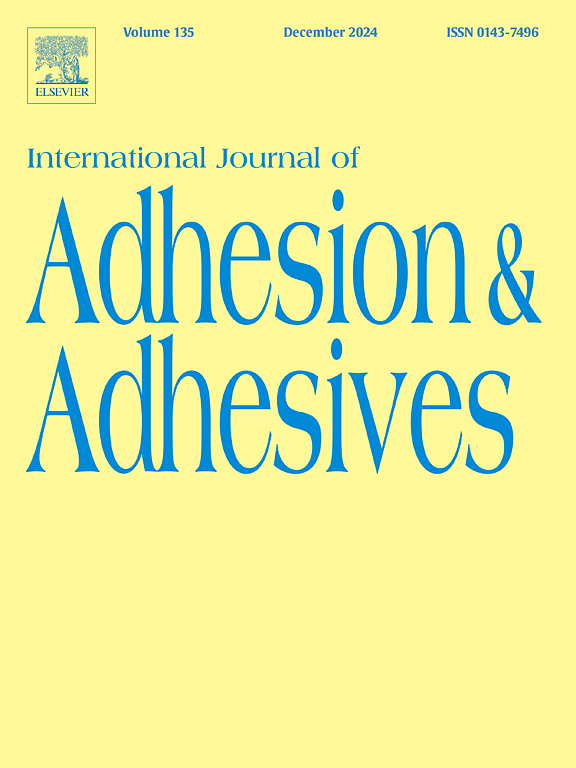Effect of passive air exposure and light contact duration on the bond strength and mechanical properties of universal adhesives
IF 3.5
3区 材料科学
Q2 ENGINEERING, CHEMICAL
International Journal of Adhesion and Adhesives
Pub Date : 2025-06-30
DOI:10.1016/j.ijadhadh.2025.104094
引用次数: 0
Abstract
Objective
This study aimed to evaluate the effects of passive air exposure (no active drying) and light contact time (under D65 light simulating daylight) on adhesive performance.
Methods
Five universal adhesives (G-Premio Bond [GC], Clearfil Universal Bond [Kuraray], Prime & Bond Universal [Dentsply], OptiBond Universal [Kerr] and Gluma Bond Universal [Kulzer]) were applied to dentin samples after different passive air exposure times (0, 5, 15, 30 s) under standard D65 artificial daylight. Micro-tensile bond strength (μTBS), fracture distance (ΔL), and elastic modulus (E) were measured. Morphological evaluation of the adhesive interfaces and fracture patterns was performed using scanning electron microscopy (SEM). Statistical analysis included two-way ANOVA to assess the main effects and interactions of adhesive type and exposure time, followed by one-way ANOVA or Kruskal-Wallis tests for group-specific comparisons. Post hoc tests (Tukey, Bonferroni, or Games-Howell) were applied when appropriate. Correlation and regression analyses were also performed. Statistical significance was set at p < 0.05.
Results
Passive air contact and light exposure significantly affected the mechanical performance of the adhesives. The GPB 30 s group showed the highest bond strength, while the elastic modulus decreased significantly (p = 0.028). The CUB 15 s group exhibited one of the highest elastic modulus values, but the adhesive fracture rate was high in the fracture type (p = 0.007). Correlation analyses showed a strong negative relationship between elastic modulus and fracture distance (r = −0.559/-0.834). SEM images revealed that air bubbles had a negative effect on bond strength.
Significance of the study
This study guides on the optimal application time for clinical applications by evaluating the effects of air and light exposure time on bonding mechanisms in universal adhesive systems. The findings suggest that adhesive application protocols should be precisely optimized.
被动空气暴露和光接触时间对通用胶粘剂粘结强度和力学性能的影响
目的研究被动空气暴露(无主动干燥)和光接触时间(D65模拟日光下)对胶粘剂性能的影响。方法5种通用胶粘剂(G-Premio Bond [GC], Clearfil universal Bond [Kuraray], Prime &;将Bond Universal [Dentsply], OptiBond Universal [Kerr]和Gluma Bond Universal [Kulzer])应用于标准D65人工日光下不同被动空气暴露时间(0,5,15,30 s)后的牙本质样品。测量微拉伸粘结强度(μTBS)、断裂距离(ΔL)和弹性模量(E)。利用扫描电子显微镜(SEM)对粘接界面和断裂模式进行形态学评价。统计分析包括双向方差分析来评估胶粘剂类型和暴露时间的主要影响和相互作用,然后采用单向方差分析或Kruskal-Wallis检验进行组间比较。适当时采用事后检验(Tukey、Bonferroni或Games-Howell)。并进行相关分析和回归分析。p <;0.05.结果被动空气接触和光照对胶粘剂的力学性能有显著影响。GPB 30s组粘结强度最高,弹性模量显著降低(p = 0.028)。CUB 15s组是弹性模量最高的组之一,但在骨折类型中粘连骨折率较高(p = 0.007)。相关分析显示弹性模量与断裂距离呈显著负相关(r = - 0.559/-0.834)。SEM图像显示,气泡对粘结强度有负面影响。本研究通过评估空气和光照暴露时间对通用胶粘剂粘接机制的影响,指导临床应用的最佳应用时间。研究结果表明,应精确优化胶粘剂的应用方案。
本文章由计算机程序翻译,如有差异,请以英文原文为准。
求助全文
约1分钟内获得全文
求助全文
来源期刊

International Journal of Adhesion and Adhesives
工程技术-材料科学:综合
CiteScore
6.90
自引率
8.80%
发文量
200
审稿时长
8.3 months
期刊介绍:
The International Journal of Adhesion and Adhesives draws together the many aspects of the science and technology of adhesive materials, from fundamental research and development work to industrial applications. Subject areas covered include: interfacial interactions, surface chemistry, methods of testing, accumulation of test data on physical and mechanical properties, environmental effects, new adhesive materials, sealants, design of bonded joints, and manufacturing technology.
 求助内容:
求助内容: 应助结果提醒方式:
应助结果提醒方式:


